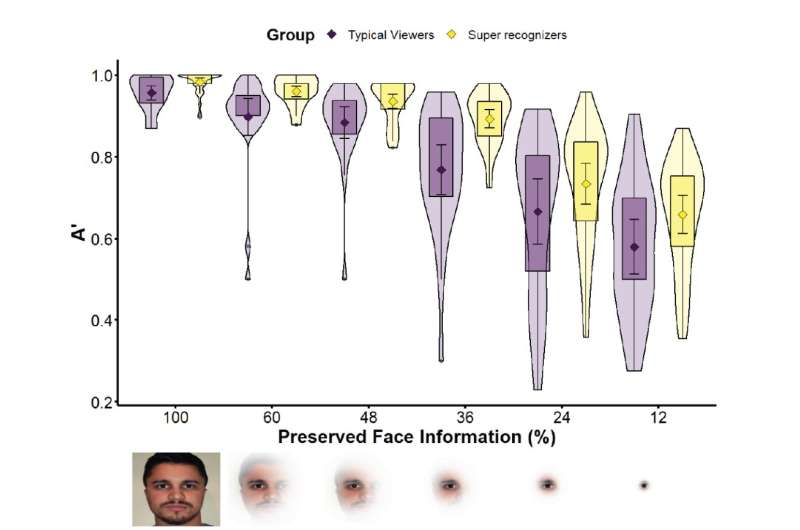'Super recognizers' can learn faces from fragments

Psychologists at UNSW Sydney and University of Wollongong have challenged the prevailing view that people with exceptional face recognition abilities rely on processing faces holistically.
Instead, they argue, people who are great at learning and remembering new faces—also known as super recognizers—can divide new faces into parts, before storing them in the brain as composite images.
"It's been a long-held belief that to remember a face well you need to have a global impression of the face, basically by looking at the center and seeing the face as a whole," said lead researcher, Dr. James Dunn.
"But our research shows that super-recognizers are still able to recognize faces better than others even when they can only see smaller regions at a time. This suggests that they can piece together an overall impression from smaller chunks, rather than from a holistic impression taken in a single glance."
In a paper published today in the journal Psychological Science, the researchers described how they set up an experiment that tested both super recognizers and people with average face recognition skills to see whether revealing only small areas of a face at a time made any difference to super recognizers' superior ability to remember a face.
Not only did super recognizers continue to perform better when only seeing small parts of a face at a time, but they seemed to spend less time looking at the eyes than other participants in the test.
But according to Dr. Dunn, the results don't mean that super-recognizers are necessarily doing anything differently than the rest of us.
"It seems that super-recognizers are not processing faces in a qualitatively different way from everyone else," Dr. Dunn said. "They are doing similar things to normal people, but they are doing some important things more and this leads to better accuracy."
The setup
The researchers recruited 37 super-recognizers and 68 typical recognizers and sat them before a computer screen. There, they looked at faces through a "spotlight" that captured up to 60 percent of the face at the largest aperture, down to just 12 percent at the smallest aperture, using eye tracking technology.
Each person had five seconds to scan an outline of a face, and only the parts of the face that their gaze illuminated was revealed in detail, with the rest blurred beyond recognition. As they looked around the face, new details of the face were revealed, while the preceding area was again obscured. They looked at a total of 12 faces.
In the next phase they were presented with 24 faces—the 12 that they had viewed in the first part of the test, and 12 new faces—and asked to identify the faces they had seen in the face learning phase.
Good lookers
It turned out that the super-recognizers were more accurate than typical recognizers whether the size of the aperture was large or very small. While there didn't seem to be a pattern in the features that super-recognizers gazed at compared to typical recognizers, there was a difference in the time that they spent looking at the eyes.
"We found that they actually look at the eyes less. This is despite the fact that a lot of research has been saying that looking at the eyes is such an important part of recognition and that the eyes do contain visual information that can give away a person's identity."
"So this was a bit of a mystery. One theory we have is that looking away from the eyes creates the opportunity to extract identity information from other features."
The researchers said their experiment changes the way we think about why some people are better than others at committing a face to memory.
"We think one of the things they're doing uniquely is exploring the face more to find information that is useful for remembering or recognizing a person later. So when super-recognizers learn a face, it is more like putting together pieces in a jigsaw puzzle than taking a single snapshot of the whole face."
Other superpowers?
So are super-recognizers good at other tasks, like matching patterns, remembering phone numbers, or having photographic memories?
While that wasn't a subject of this particular study, Dr. Dunn said that in another study recently published in Psychonomic Bulletin & Review they found that those who are good at comparing images of people's faces—like comparing someone's face to their driver's license photo—may also be good at comparing other types of visual patterns.
"We are starting to find evidence from super-recognizers and the public that people who were accurate when matching photographs of faces also tended to be more accurate matching other types of visual patterns, like the fingerprint and firearm samples that are analyzed by forensic scientists."
"This leads us to believe that there is a general ability to compare complex visual patterns that is shared across different objects, which means that the same skills that make someone good at matching faces may also help you compare these other patterns as well," he said.
Looking ahead, Dr. Dunn and his fellow researchers are keen to take super-recognizing out of the lab and into the real world. They plan to have super-recognizers wear special eye-tracking glasses that record what their eyes are doing as they move about in the world and interact with people.
"We'd like to see whether some of the things we've observed in the lab about how super-recognizers learn and remember faces are the same in their day-to-day life."
More information: James Daniel Dunn et al, Face information sampling in super-recognizers, Psychological Science (2022). journals.sagepub.com/doi/10.1177/09567976221096320
Bethany Growns et al, Match me if you can: Evidence for a domain-general visual comparison ability, Psychonomic Bulletin & Review (2022). DOI: 10.3758/s13423-021-02044-2




















